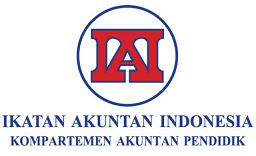PENGARUH UKURAN PERUSAHAAN, FINANCIAL LEVERAGE, DIVIDEND PAYOUT RATIO, DAN NILAI PERUSAHAAN TERHADAP PERATAAN LABA
Abstract
This study aimed to examine the effect of Firm Size, Financial Leverage, Dividend Payout Ratio, and Firm Value toward Income Smoothing in BUMN Companies Listed on Indonesia Stock Exchange. Income Smoothing measured by Index Eckel’s. The Population in this study is BUMN companies listed on the Indonesia Stock Exchange in 2015-2019 Based on the purposive sampling method, the sum of a sample obtained from the population is 16 companies. Sources of data obtained from annual reports of companies listed on Indonesia Stock Exchange in 2015-2019. The analytical method for this study uses logistic regression analysis and Mann Whitney test with SPSS 21. Based on the result of the analysis showed Firm Size, Financial Leverage, Dividend Payout Ratio, and Firm Value are not influence Income Smoothing.
Downloads
References
Arfan, Muhammad dan Desry Wahyuni. 2010. Pengaruh Firm Size, Winner/Loser Stock, dan Debt to Equity Ratio Terhadap Perataan Laba (Studi Pada Perusahaan Manufaktur yang Terdaftar Di Bursa Efek Indonesia). Jurnal Telaah & Riset Akuntansi Vol. 3 (1).
Budiasih, Igan. 2009. Faktor-faktor Yang Memengaruhi Praktik Perataan Laba. Jurnal Akumtansi. Fakultas Ekonomi Universitas Udayana Bali.
Copeland,R. M. 1968. “Income Smoothing, Journal of Accounting Research”, Empirical Reseacrh in Accounting, Selected studies 6 ( Supplement).
Framita, Dien Sefty. 2018. Pengaruh Return On Asset (ROA), Net Profit Margin (NPM), Debt To Eqiuty Ratio (DER), Leverage Operasi, dan Ukuran Perusahaan Terhadap Praktik Perataan Laba pada Perusahaan Manufaktur Sektor Industri Dasar dan Kimia yang Terdaftar di BEI. Jurnal Akuntansi, Vol 5 No. 2. Hal 107-117.
Husnan, Suad. 2000, Manajemen Keuangan Teori dan Penerapan (Keputusan Jangka Panjang, Yogyakarta: BPFE.
Jogiyanto. 2012. Teori Portofolio dan Analisis Investasi: Edisi Ketujuh. Yogyakarta. BPFE –Yogyakarta
Juniarti dan Carolina. 2005. “Analisa Faktor-Faktor yang Berpengaruh Terhadap Perataan Laba (Income Smoothing) pada Perusahaan-Perusahaan Go-Public. Jurnal Akuntansi dan Keuangan Vol 7, No. 2. Hal; 148-162
Lahaya, Ibnu. Abdi. (2017). Pengaruh Dividend Payout Ratio, Risiko Keuangan, Nilai Perusahaan, dan Ukuran Perusahaan terhadap Perataan Laba (Studi pada Perusahaan Manufaktur Sektor Industri Dasar dan Kimia Listing di Bursa Efek Indonesia). Akuntabel, 14(1)
Mahmud, Nurfarizan Mazhani. (2012). Income Smoothing and Industriak Sector. Elixir International Journal. 10248-10252.
Nehemia, Oscar. 2015. “Pengaruh Profitabilitas, Financial Leverage, Dividend Payout Ratio, dan Nilai Perusahaan Terhadap Praktik Perataan Laba(Income Smoothing. Fakultas Ekonomi. Universitas Pasundan. Bandung.
Pratiwi, Ni Wayan Piwi Indah, & Damayanthi, I Gusti Ayu Eka (2017). Analisis Perataan Laba dan Faktor-faktor yang Memengaruhinya. E-Jurnal Akuntansi Universitas Udayana, Vol. 20(1), 496–525.
Pramono, Olivya. (2013). Analisis Pengaruh ROA, NPM, DER, dan Size terhadap Praktik Perataan Laba (Studi Kasus pada Perusahaan Manufaktur yang terdaftar di Bursa Efek Indonesia Periode 2007-2011). Jurnal Ilmiah Mahasiswa Universitas Surabaya, 2(2), 1–16.
Riahi-Belkaoui, Ahmed. 2012. Teori Akuntansi:Edisi Lima. Jakarta: Salemba Empat.
Santoso, Eko Budi dan Sherly Novia Salim,. 2012. “Pengaruh Profitabilitas, Financial Leverage, Dividen, Ukuran Perusahaan, Kepemilikan Institusional, Dan Kelompok Usaha Terhadap Perataan Laba Studi Kasus Pada Perusahaan Non-Finansial Yang Terdaftar Di Bei. ” Vol 1 pages 185-200
Sulistiyawati. 2013. “Pengaruh Nilai Perusahaan, Kebijakan Dividen, dan Reputasi Auditor Terhadap Perataan Laba. ” AAJ Vol. 2 pages 148-153.
Suranta, Eddy dan Pratama Puspita Merdiastuti. 2004. “Income Smoothing, Tobin’s Q, Agency Problems dan Kinerja Perusahaan”. Simposium Nasional Akuntansi VII,pages 340-357
Jurnal Akutansi dan Keuangan allows readers to read, download, copy, distribute, print, search, or link to the full texts of its articles and allow readers to use them for any other lawful purpose. The journal allows the author(s) to hold the copyright without restrictions. Finally, the journal allows the author(s) to retain publishing rights without restrictions
Authors are allowed to archive their submitted article in an open access repository
Authors are allowed to archive the final published article in an open access repository with an acknowledgment of its initial publication in this journal







